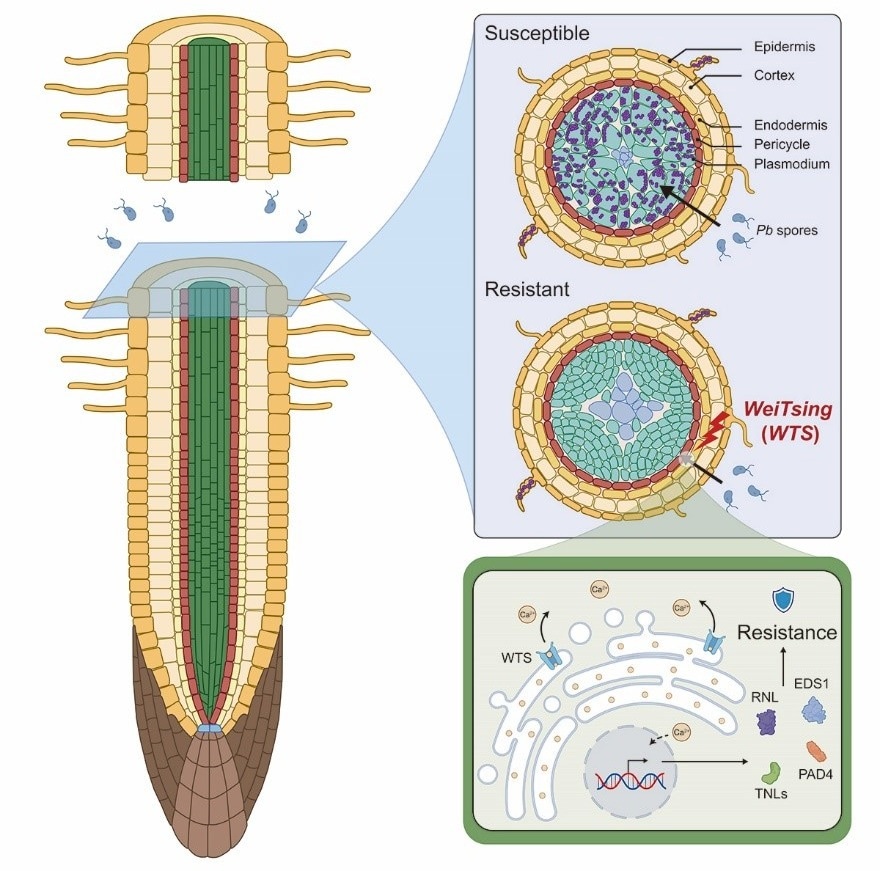Scientists from the Chinese Academy of Sciences’ Institute of Genetics and Developmental Biology, spearheaded by Yuhang Chen and Jianmin Zhou, have demonstrated how plants fight clubroot, a significant root disease that threatens the productivity of Brassica crops like rape.
 WTS encodes an ER-localized Ca2+ release channel, triggering an immune response to protect stele from P. brassicae invasion. Image Credit: Hangyuan Cheng.
WTS encodes an ER-localized Ca2+ release channel, triggering an immune response to protect stele from P. brassicae invasion. Image Credit: Hangyuan Cheng.
The research was published in the journal Cell, which described new mechanisms driving plant immunity and presents a new avenue for crop breeding.
The most devastating disease of Brassica crops is clubroot, a soil-borne disease. Clubroot affects roughly 3.2–4 million hm2 of agricultural land in China annualy, leading to a 20–30% yield loss. Plasmodiophora brassicae (Pb), the causal pathogen of clubroot, can survive in the soil for up to 20 years, rendering contaminated soil unfit for Brassica crops.
Only two clubroot resistance genes have been cloned so far, and their resistance has been compromised by recently developed virulent Pb strains.
The newly discovered resistance gene WeiTsing (WTS) gives resistance to all Pb isolates evaluated in this study, including isolates that are virulent against current resistant rape varieties. As a result, WTS is a broad-spectrum resistance gene with high promise for developing crop resistance to clubroot disease.
In the absence of the pathogen, WTS is not expressed. WTS, on the other hand, is highly induced exclusively in the pericycle, a significant layer of root cells surrounding the stele after Pb infection. The stele is a cylindrical central vascular section of the root that contains key tissues, such as the xylem and phloem, which are required for nutrient and water transport.
Pb invades and colonizes the stele of vulnerable plants, obstructing nutrition and water transport. The pericycle expression of WTS stimulates plant defenses and inhibits Pb from invading the stele. WTS thus denotes a defense mechanism that is particularly engaged at the appropriate location and time to ensure normal plant growth and development.
WTS also encodes a new protein. WTS self-assembles into a hitherto unknown pentameric architecture with a central pore, according to cryo-EM structural investigation.
Further research has revealed that the WTS protein complex acts as an endoplasmic reticulum-localized calcium release channel, increasing cytosolic calcium ions, an important secondary signal for plant defense activation.
The scientists’ discovery of fascinating disease resistance mechanisms represents a new paradigm in plant defense against soil-borne pathogens. The cloned WTS gene provides new hope for breeding Brassica crops immune to a deadly disease that has previously been impossible to control.
Source:
Journal reference:
Wang, W., et al. (2023). WeiTsing, a pericycle-expressed ion channel, safeguards the stele to confer clubroot resistance. Cell. doi.org/10.1016/j.cell.2023.05.023.